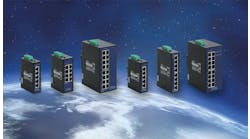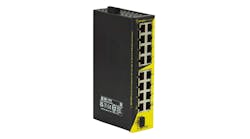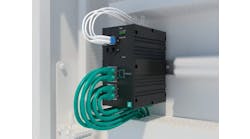Call 513/742-8895, ext. 332, email [email protected] or browse to www.advantech.com.
"There is no existing protocol standard for fast deployment and easy maintenance of managed Ethernet switches," says Ken Kao, product manager, Advantech. "Advantech created the proprietary protocol, now built-in to our industrial Ethernet switches, based on the real user installation scenarios in real applications. We set out to solve the user’s current network configuration, management and maintenance pain points."
Advantech developed an industrial Ethernet switch solution to help the users quickly deploy the industrial Ethernet switch hardware. Advantech IXM technology allows users with multiple, managed Ethernet switches in the field to eliminate the need to individually connect to each device to configure it. All that’s required is to connect to a single IXM-enabled switch on the network and log in. This managed switch can connect to and configure all other IXM-enabled switches on the network at the same time in the same topology.
Cross-managed
Kao describes the IXM technology as a "cross management" feature built into Advantech’s industrial-grade managed Ethernet switch family to help the user deploy and maintain the application. The VPN Router is the L3 core network router; the EKI-7000 series is the L2 distributed network level managed switch; and the ProView EKI-5000 series is the L2 edge network level lite-managed switch.
Cross management allows an IXM-enabled switch, anywhere in the network topology, to be cross-managed by a neighboring VPN router or EKI-7000 managed switch in the same environment (networking subnet). The cross management can be used for configuration synchronization, firmware synchronization and IP address assignment.
"It's the major benefit of this switch—the ability to do a fast deployment," notes Kao. The Web server allows all the switches, in one topology, to be configured through one connection. The switches can be configured as a group or individually all from a single location.
"We have seen the customers facing the challenge of installation in the field, the one-by-one configuration of each switch requires significant effort and the potential human error due to the large number of manual settings required," comments Kao. "Normally, the engineer has to spend around 15-20 min to finish the initial setting for each managed switch. Imagine if you have to install 100 managed switches. Then imagine from the maintenance point view, updating the firmware in these 100 switches. It takes a significant amount of time and now Advantech has a more efficient way to help our customer configure and upgrade managed switches."
Traditionally, when a user purchases a managed switch, the IT engineer or network engineer must physically connect to each switch and set the IP address. The engineer also needs to set up the virtual local area network (VLAN) or network management protocols in each switch. Without IXM, each switch is individually and locally configured. It's a very one-on-one configuration experience. With 15 switches, you need to connect, set the IP address and configure the features 15 times. Another option is to use network management software that must be installed on a PC. The software is then used to select the features, configuration and upgrades. However, this software costs money for the license to use it.
"You don't need to install the software utility on to your PC,” says Kao. “It's all available as part of the IXM functionality. Just log into the switch and all of the IXM functionality and every IXM switch on the network are available via the switch Web server."
With the IXM Ethernet switches, the configuration tools are built-in. The software is on the switch and accessible with a simple network connection. When working with the EKI-7000 managed switch, it is only necessary to log into the Web server built into the switch, enable IXM technology and do the appropriate setting through the Web graphical user interface.
"Advantech uses wizards to walk you through deployment," comments Kao. "It's a step-by-step process during the configuration synchronization, firmware synchronization or IP address assignment. The IXM functionality steps you through instructions on source device selection, target device(s) selection and features configuration selection and then requests confirmation of selections before processing. The source is simply the device whose configuration or firmware to synchronize, and the target is the device to be synchronized. Protocols configuration such as IGMP, STP, SNMP, LLDP, Modbus TCP, PoE and so on can be selected for synchronization."
Wide range of hardware
The IXM technology is supported in a wide-ranging product family. The Advantech ProView EKI-5000 series is an unmanaged Ethernet switch but has a built-in real-time remote-monitoring capability through SNMP or Modbus/TCP agent. The remote monitoring capability was the first to the market and is a great option for machine monitoring. While it doesn't have the IXM deployment wizard, ProView can easily be configured by an EKI-7000 series managed switch via IXM technology and comes in a variety of port counts and speeds.
The proprietary IXM deployment wizard built into the EKI-7000 managed switch makes it the master or source of the configuration/firmware synchronization. The EKI-7000 switch is available in both DIN-rail and 19-in rack-mount version with a variety of port counts (8 to 24) and speeds (10/100/1000 Mbps). This device also comes in a wide temperature range (-40 to 75 °C) and offers a proprietary X-ring feature for self-healing as a networking redundancy capability.







